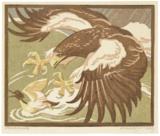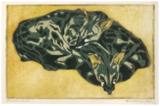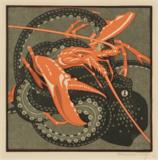Norbertine Bresslern-Roth *

(Graz 1891–1978)
Rast I / Repose, signed B Roth, oil on burlap (Jute), 140 x 150 cm, original frame
Illustrated and registered in:
Helene Martischnig, Norbertine Bresslern-Roth (1891–1978). Das malerische Werk, Dipl. Arb. Graz, 1994, cat. rais. no. I/124, ill. no. 124, p 33.
Christa Steinle (ed.), Norbertine Bresslern-Roth (1891–1978). Tiermalerin, exhibition catalogue Neue Galerie Universalmuseum Joanneum, Graz 2016, cat. rais. no. 178, ill. p. 261
Illustrated in:
Bresslern-Roth. Eine Hommage im St. Veiter Schloessl zu Graz, Michael Stoff, Eigenverlag 2003, ill. p. 20–21
Exhibited in:
Landesmuseum Joanneum, Graz, 1940
St. Veither Schlössl, Graz, 2003
Universalmuseum Joanneum, Graz, 26.10.2016–17.04.2017
Provenance:
Private collection Styria, acquired directly from the artist
with Kunsthandel Manfred Srna, Graz by 1990
Private collection, Styria
“I just want to reproduce the characteristic.”
Norbertine Bresslern-Roth
Norbertine Bresslern-Roth was celebrated by Austrian and international critics during her lifetime as one of the most important painters of animals of the modern age. She was born in Graz, where she would go on to work as an artist. She developed an independent technique early on that made her paintings and numerous linocuts distinctive. Bresslern-Roth placed particular emphasis on the material, the properties of which she was able to exploit in the painting process. From 1920 onwards, she chose burlap as her painting surface. The coarse surface of woven burlap along with the strong absorbency of the primer she applied gave her paintings a fresco-like, colourful, shimmering overall impression. This special painting application transformed her well thought-out, precisely composed paintings into spontaneous impressions that captured the moment.
After a trip to Libya in 1928, Bresslern-Roth discovered the living world of Africa and later also of the South Sea Islands, which seemed exotic to her. She transformed her observations into her personal notion of the ideal coexistence of man, nature and animals. A major work within this figurative thematic group is the monumental painting of the “Repose.” In no other work does the artist succeed in creating such a balanced composition, in which the idea of harmony, peace and tranquillity is expressed so powerfully. Within a circular arrangement, humans and animals are lined up in an up-and-down rhythm. The S-shaped interlacing of the two girls lying in the centre can also be read as the well-known Chinese sign of Yin and Yang. Their innocent nakedness coupled with the tamed domestic animals – a dog, a pig, and a donkey – also symbolise the contrast to the wildness of nature. The painting exudes a serene matter-of-factness where man and animal surrender to sleep in peaceful coexistence.
In 1940 the painter received an invitation to participate in the exhibition “Heimat in Arbeit und Kampf” in the Landesmuseum Joanneum in Graz. It was not advisable for the reclusive living artist and wife of a half-Jew to decline her participation. She decided to send in this painting, the message of which is almost unmistakable: the longing for peaceful rest and harmonious coexistence of man and animal instead of work under the sign of dictatorship and war.
Specialist: Dr. Marianne Hussl-Hörmann
 Dr. Marianne Hussl-Hörmann
Dr. Marianne Hussl-Hörmann
+43-1-515 60-765
marianne.hussl-hoermann@dorotheum.at
30.11.2021 - 18:00
- Estimate:
-
EUR 170,000.- to EUR 220,000.-
Norbertine Bresslern-Roth *
(Graz 1891–1978)
Rast I / Repose, signed B Roth, oil on burlap (Jute), 140 x 150 cm, original frame
Illustrated and registered in:
Helene Martischnig, Norbertine Bresslern-Roth (1891–1978). Das malerische Werk, Dipl. Arb. Graz, 1994, cat. rais. no. I/124, ill. no. 124, p 33.
Christa Steinle (ed.), Norbertine Bresslern-Roth (1891–1978). Tiermalerin, exhibition catalogue Neue Galerie Universalmuseum Joanneum, Graz 2016, cat. rais. no. 178, ill. p. 261
Illustrated in:
Bresslern-Roth. Eine Hommage im St. Veiter Schloessl zu Graz, Michael Stoff, Eigenverlag 2003, ill. p. 20–21
Exhibited in:
Landesmuseum Joanneum, Graz, 1940
St. Veither Schlössl, Graz, 2003
Universalmuseum Joanneum, Graz, 26.10.2016–17.04.2017
Provenance:
Private collection Styria, acquired directly from the artist
with Kunsthandel Manfred Srna, Graz by 1990
Private collection, Styria
“I just want to reproduce the characteristic.”
Norbertine Bresslern-Roth
Norbertine Bresslern-Roth was celebrated by Austrian and international critics during her lifetime as one of the most important painters of animals of the modern age. She was born in Graz, where she would go on to work as an artist. She developed an independent technique early on that made her paintings and numerous linocuts distinctive. Bresslern-Roth placed particular emphasis on the material, the properties of which she was able to exploit in the painting process. From 1920 onwards, she chose burlap as her painting surface. The coarse surface of woven burlap along with the strong absorbency of the primer she applied gave her paintings a fresco-like, colourful, shimmering overall impression. This special painting application transformed her well thought-out, precisely composed paintings into spontaneous impressions that captured the moment.
After a trip to Libya in 1928, Bresslern-Roth discovered the living world of Africa and later also of the South Sea Islands, which seemed exotic to her. She transformed her observations into her personal notion of the ideal coexistence of man, nature and animals. A major work within this figurative thematic group is the monumental painting of the “Repose.” In no other work does the artist succeed in creating such a balanced composition, in which the idea of harmony, peace and tranquillity is expressed so powerfully. Within a circular arrangement, humans and animals are lined up in an up-and-down rhythm. The S-shaped interlacing of the two girls lying in the centre can also be read as the well-known Chinese sign of Yin and Yang. Their innocent nakedness coupled with the tamed domestic animals – a dog, a pig, and a donkey – also symbolise the contrast to the wildness of nature. The painting exudes a serene matter-of-factness where man and animal surrender to sleep in peaceful coexistence.
In 1940 the painter received an invitation to participate in the exhibition “Heimat in Arbeit und Kampf” in the Landesmuseum Joanneum in Graz. It was not advisable for the reclusive living artist and wife of a half-Jew to decline her participation. She decided to send in this painting, the message of which is almost unmistakable: the longing for peaceful rest and harmonious coexistence of man and animal instead of work under the sign of dictatorship and war.
Specialist: Dr. Marianne Hussl-Hörmann
 Dr. Marianne Hussl-Hörmann
Dr. Marianne Hussl-Hörmann
+43-1-515 60-765
marianne.hussl-hoermann@dorotheum.at
|
Buyers hotline
Mon.-Fri.: 10.00am - 5.00pm
kundendienst@dorotheum.at +43 1 515 60 200 |
| Auction: | Modern Art |
| Auction type: | Saleroom auction with Live Bidding |
| Date: | 30.11.2021 - 18:00 |
| Location: | Vienna | Palais Dorotheum |
| Exhibition: | Online |
More objects by this artist
-

Starting bid:
EUR 800.- -

Starting bid:
EUR 700.- -

Starting bid:
EUR 600.-
